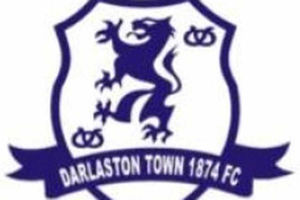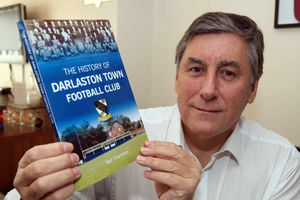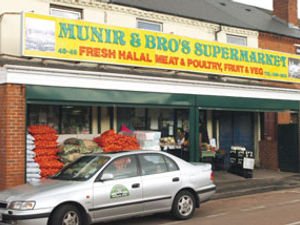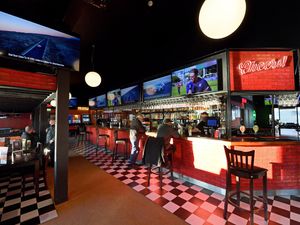The birth of Darlaston Town (1874) FC
As this is the first of the blogs on Darlaston Town, and given the time of year, it's probably only right we start with something a bit uplifting.

Earlier in the month, despite letting a two-goal lead slip, Darlaston Town (1874) eventually overcame Bartley Green Illey in a five goal thriller to go two points clear at the top of division two of the West Midlands Regional League.
Being top of the table moving towards the end of 2014 is all the more remarkable when you consider that at the start of the year, there was no team, side or – in essence – club, bearing the name Darlaston Town.
Generally speaking, it takes something monumental to happen in non-league football for it to get much attention in the mainstream media.
The seemingly sudden closure of the 140-year-old Darlaston Town Football Club part way through the 2012-2013 season did exactly this, hitting the headlines as a club believed to be among the oldest in the land folded.
Darlaston, it seemed, would fade into history alongside famous non-league clubs including Halesowen Harriers, Brierley and Hagley, Oldbury United and Bloxwich Town.
To anybody who had visited the club's Waverley Road home in the three or four years before, the news was little surprise.
Known around the country for its traditional century-old stand and sloping pitch, what could once be described as 'charming' had become an albatross around the neck of the club.
Permanently lurking around the foot of the West Midlands Regional League, a string of managers trying hard to keep the playing side afloat as the club suffered vandalism and disrepair, the writing had been on the wall for some time.
The reasons for the club's decline were many and varied, linked to challenges that will be familiar to almost all clubs at that level and inevitably coupled to finances.
It was a sad, quiet demise for a club that can boast two England internationals and five FA Cup winners in their illustrious history.
Thankfully, however, this was not the end as the publicity from the closure sparked a reaction which culminated in the creation of a new club, named Darlaston Town (1874).
A group of fans held public meetings, set up a new committee and raised funds to set up and run the club. They voted for a new name and registered the club with the FA.
Temporarily squatting at the Bentley Road South home of Red Star Alma while more long-term plans are put into motion, the first manager – indeed, player-manager – of the new club is Mark Swann.

Something of a character in non-league circles, the 35-year-old PE teacher at the Grace Academy himself played for Darlaston in happier days for the club.
Nicknamed 'Swannaldo', his goalscoring exploits will be remembered fondly by fans of Tipton, AFC Wulfrunians and Bilston Town, among many others.
Still as prolific as ever, his two goals against Bartley Green Illey were his 16th and 17th of the season, making him the league's top scorer by some margin.
"If I'm completely honest, we were perhaps caught a little bit cold at the start of the season," he admits. "We might have misjudged the standard at this level.
"But after a shaky start, we had a rethink, brought in some young and hungry players, went on a nine match winning run and the rest is history.
"Obviously, there's a long way to go but the club is ambitious and the levels of support and professionalism are excellent. Hopefully we can continue to put the points on the board and kick on."
So, with things going well on the pitch as they chase one of the two promotion slots available, what of the club's health off the pitch?
Having effectively dropped two leagues as a result of the original club folding, the new committee are under no illusions about the long hard fight back to even where they were before.
The club's chairman, Neil Chambers, had a long involvement with Darlaston Town, through good times and bad, with a break in the middle due to career commitments.
Under his leadership the club has been keen to emphasise its community roots and has already earned FA Chartered Standard Club status.

"When we started, our immediate aim was to get a team called Darlaston Town back playing senior football," he explains. "The response from the community was overwhelming and we set about securing the funds to be able to put out a team for a season, bearing in mind we inherited nothing.
"What was important was to get playing again quickly – the longer you're out of the public eye the harder it is to get back as we've seen with other clubs down the years.
"Mark Swann has been a huge asset – someone who really understands the club, the town and what we are trying to do here.
"Perhaps most impressive is the support. We're having crowds which teams three or four divisions further up would be happy with, which suggests we've got the base to press on."
The success of the senior side has inspired people at the club thinking about expanding the number of teams to include youth and junior sides, helping to create a club in the truest sense of the word.
Of course, the thorny issue of having a permanent base to call home is never far from the minds of the committee members.
It's a challenge for any ambitious grassroots club as having a home ground enables you to generate income and revenue denied clubs that rent their pitches.
It is something the club have clearly been working on and, while nothing has yet been confirmed, an announcement about plans beyond the end of this season is expected soon.
In the meantime, the young side assembled by Swannaldo will have to do their part notching up the points to push Darlaston back where their supporters believe they belong.
Keep up to date with Darlaston Town (1874) FC here.
Follow Mat Danks on twitter @matdanks666




